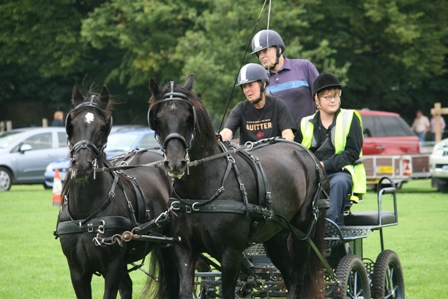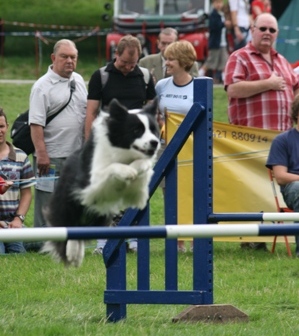Kay Adkins, hot tub correspondent
Edition number 11; dateline 2 October 2008
Animals: their lives in our hands
My thoughts this month turn to our furry friends with two things setting me thinking about our relationship with animals when taking part in sport and active recreation.
The first was bumping into Andy Blackford (‘famous’ columnist of Runners World and Triathlon World, and author of Running on Empty) on the train. When you meet a renowned author in the flesh you want to find out more about his work and while reading Andy’s perceptive words on running I learned that his most regular running companion is “Oscar, the World’s Fittest Dog”.
The second thing to set me thinking occurred while scanning the latest copy of the Shape Up Notts newsletter [qv TLR July 2008]. It was here I came across an opportunity to go racing with Jack, the ‘World’s Laziest Jack Russell’ in Sherwood Forest if I joined the exciting sport of cani-cross. This is where I am encouraged to attach the hapless pooch to a lead, which in turn is attached to a belt, the theory being he then pulls me around the forest. Apparently I can teach him to pull only when competing. They obviously don’t know Jack! Sounds like a good idea to me and I wonder if they will allow similar tactics in the triathlon I am competing in this Sunday?
As I thought further about Jack becoming my new weapon for increasing speed on runs I began to consider the impact on him. Jack is about 8 inches tall at his shoulder and weighs approximately 24lbs while I am 5’6” and just a touch heavier. He does punch a pretty good power-to-weight ratio but even so, should he really be dragging me around a forest? Well he does anyway, whether I or any animal cruelty charities want him to or not. And remember he did catch me when I fell down a hill during the TLR Summer Conference while our human companions just stood and watched him perform this feat of strength. So perhaps it is OK to do sport with Jack.
Of course, many of us exercise alongside our dogs. Many fitness campaigns in the past have encouraged us to do just that as an alternative to lining the pockets of those evil leisure centre gym owners. But what about more mainline sports that involve animals? In my dim and increasingly distant past I was very involved in the horse world and alongside competing with Dino, my extremely fit and fast thoroughbred, I also coached and managed teams all the way up to world and European levels.
Most of the time when you are working with the horses and their riders – or drivers – it doesn’t occur to you to think about the morality of asking the horses to compete alongside us in our quest for glory. For most equestrians it is a way of life and this activity has been going on around us since birth but every now and again some non-horsey person will chirp up: “Isn’t it cruel?” Usually around the time of the Grand National. Which begs two questions: do the horses want to compete and is it harmful to them? I have a number of answers.
I’m not sure they understand competing in the same way as we do but some definitely like beating their fellow equines if it comes to a race. How do I know this? Other than observing many races where I have seen horses literally stretch their necks out a little more to beat the next straining thoroughbred, I have also been ‘crew’ to Gordon, a rather pretty grey arab who lives just over my back fence. Gordon is an endurance horse and races up to 100 miles in a day. In order to do so he has to have a crew to tend to his needs at various points along the way and provide four serious ‘pit stops’ where he is checked by the vet to ensure he is fine to continue; and we make sure the rider is sufficiently fed to ensure they do no damage to the horse. If Gordon thinks at any time that another creature is trying to go faster than him he will lay his ears back and push it out of the way; he has even been known to swing in a bite or kick if he can get close enough. He wants to be in front. I would also say he wants the glory as he often struts around afterwards like an over-paid footballer.
Have you ever tried to get half a tonne of horse flesh to do anything it really doesn’t want to? Yes, there are ways of tricking it into taking its medicine or calming its fears about that monster of a discarded crisp packet in the hedge bottom but I can assure you that if the horse doesn’t want to gallop quickly, jump a fence or just generally move forward it won’t and us little old humans can’t make it. If it doesn’t want to play it will make its feelings very clear.
Any activity can be harmful for any of us and I would be wrong to say that engaging in activities with us bipeds is entirely without risk for the horses involved. However, the level of checks and safety precautions which are taken when any animal is competing alongside us is extremely high. They are trained (just like us lot) with the best of scientific research sitting behind them and for the elite (and for many of the non-elite) they have physiotherapists, equine sport scientists and so on They also have access to treadmills, water therapy pools and infra-red heaters that hang in their stables to ease their aching muscles after a hard session.
Horses (don’t ask me why) love pleasing and being with humans; just like the UK and America, we have a special relationship. Most humans ensure they put their horsey friend in to the least danger possible (unlike the Americans with us) and go extraordinary lengths to ensure their safety and welfare. Having also spent a lot of time with dogs, I am pretty sure that they are in the same place as horses when they compete with or for us (sledge racing and dog racing), although admittedly those lovely greyhounds are tricked a little into chasing that fluffy rabbit.
Finally my thoughts went to the racing pigeon. As granddaughter of a former pigeon-racing club secretary, I should be an expert on this but sadly, other than occasionally sitting outside the loft when fetching granddad back for “a bit o’ dinner”, I didn’t have much to do with the sport. However, I do know that these birds do build up a relationship with their human companions, they undergo physical training (there is a flock who ‘train’ over my house almost daily) and that they are treated to the best of everything. Any bird that doesn’t want to play just simply doesn’t go home.
So where have all my thoughts and philosophising taken me? Not surprisingly, after examining my conscience again, I am comfortable that our favourite ‘fluff puppies’ or our serious animal partner in sport are on the whole happy to join us in our sporting and physical activity endeavours. I am sure that there are a few unscrupulous people who break the trust of these faithful creatures and don’t treat them as they should but there are far more who respect their friends and give them all the support – and more – in return for their joint efforts.
Despite being the world’s laziest jack russell, Jack will continue to train with me and we will save each other from whatever danger lurks around the next corner until one or both of us is too old to keep up with the other. We hope to see you out there with your canine companion and a clear conscience. Give us a cheery wave as you jog by.
Kay Adkins is an executive board member of a county sport partnership, chair of a CSN and a member of the interim board of the National Skills Academy for Sport and Active Leisure. Kay is also managing director of KAM Ltd, which offers a range of support services in the sport and leisure industry working in volunteer/workforce development and facility development.
Tales from a tub
the last word in contemplative comment on the leisure industry
Kay Adkins, hot tub correspondent

“Have you ever tried to get half a tonne of horse flesh to do anything it really doesn’t want to?”

Jack: rescue dog extraordinaire